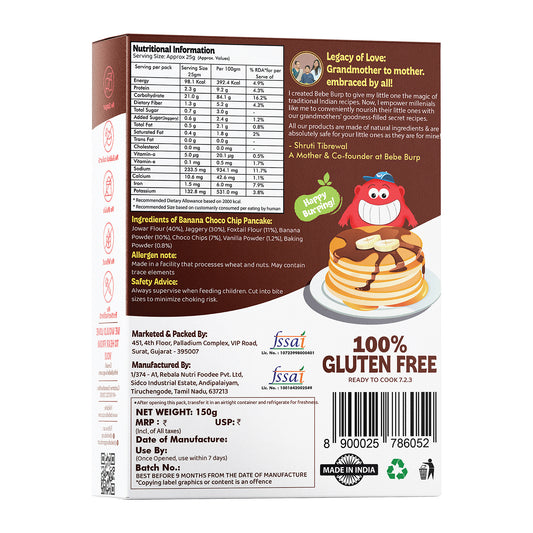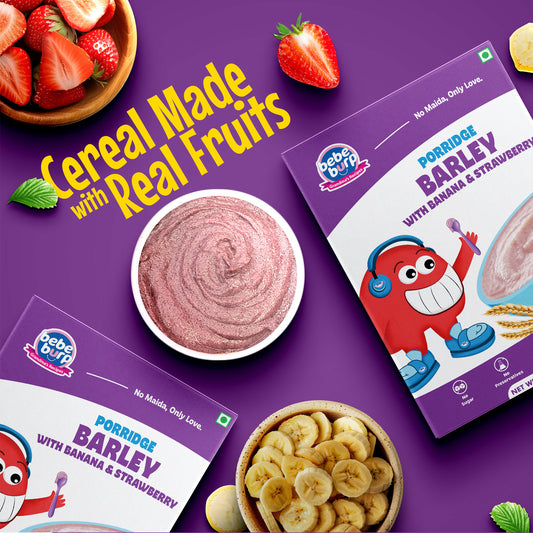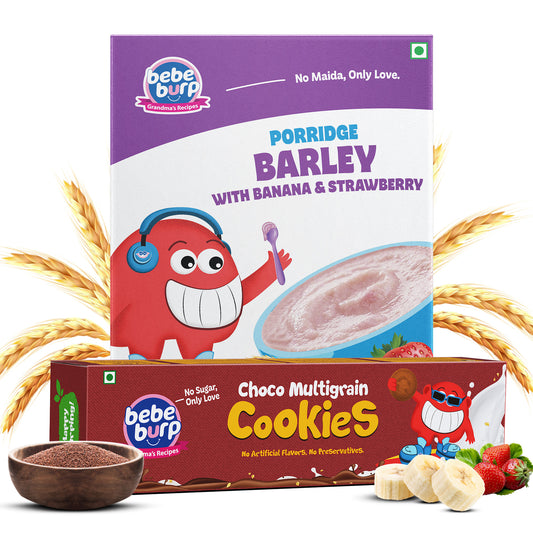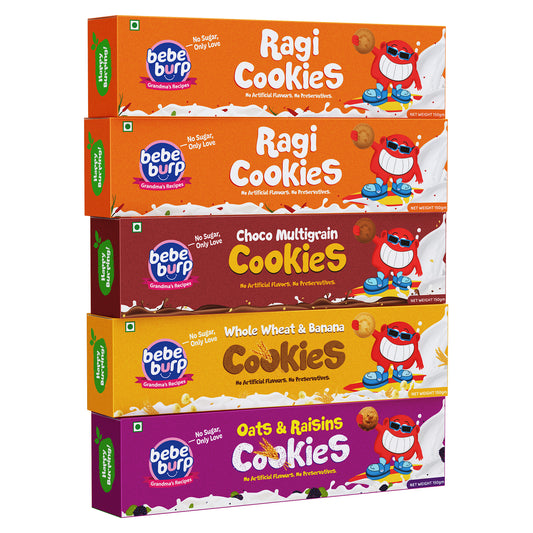INTRODUCTION
Ragi roti, also known as finger millet bread, has been gaining popularity in a baby's diet due to its numerous health benefits and nutritional value. Major highlights of ragi roti benefits are that it is a rich source of essential nutrients like calcium, iron, and dietary fiber, making it an excellent addition to a baby's diet. The high calcium content promotes bone development and strengthens teeth, while iron aids in the production of red blood cells and prevents anemia. Ragi is easily digestible and has a low glycemic index, making it suitable for babies with sensitive digestive systems. Overall, the growing popularity of ragi roti in a baby's diet is attributed to its significant role in promoting optimal growth, development, and overall well-being in infants.
This insightful blog will highlight ragi roti benefits and also elaborate on the importance of this meal in your baby’s diet.
NUTRITIONAL PROFILE OF RAGI ROTI
Ragi is rich in essential nutrients, including calcium, iron, dietary fiber, and antioxidants. The high calcium content in ragi supports the development of strong bones and teeth in growing babies. Iron, on the other hand, aids in the production of red blood cells and helps prevent iron deficiency anemia. Ragi is also a good source of dietary fiber, promoting healthy digestion and preventing constipation in babies. Additionally, it contains antioxidants that help protect against cell damage and support overall immune health. Ragi is easily digestible and gluten-free, making it suitable for babies with sensitive digestive systems or gluten intolerance.
Overall, ragi stands out as a nutrient-dense grain, providing a range of essential nutrients vital for the healthy growth and development of babies. Here’s a few of the key components that highlights ragi roti benefits for kids -
- Fiber: Ragi roti is rich in dietary fiber, which aids in digestion, regulates bowel movements, and prevents constipation. It also promotes the growth of beneficial gut bacteria, supporting a healthy gut microbiome in babies.
- Protein: Ragi is a good source of plant-based protein, essential for building and repairing body tissues, promoting muscle development, and supporting overall growth. Protein is particularly important during the early stages of a baby's life when rapid growth occurs.
- Vitamins: Some ragi roti benefits include containing various vitamins, including vitamin B-complex (such as thiamin, riboflavin, and niacin), vitamin E, and vitamin K. These vitamins play vital roles in energy metabolism, brain development, maintaining healthy skin, promoting blood clotting, and strengthening the immune system.
- Minerals: Ragi is rich in essential minerals like calcium, iron, phosphorus, and potassium. Calcium is crucial for bone and teeth development, while iron supports the production of red blood cells and prevents anemia. Phosphorus is essential for proper bone growth and development, and potassium helps maintain a healthy fluid balance and supports heart function.
Ragi, offers unique nutritional advantages for babies compared to other commonly consumed grains. Here is a comparison highlighting some of the key differences:
- Calcium content: Ragi stands out for its exceptionally high calcium content compared to other grains like rice, wheat, and corn.
- Iron content: Ragi is also a superior source of iron compared to many other grains. Iron is essential for the production of red blood cells and the prevention of iron deficiency anemia, which can be common in infants.
- Dietary fiber: Ragi is known for its high dietary fiber content compared to refined grains. Fiber aids in digestion, regulates bowel movements, and supports a healthy gut.
- Gluten-free alternative: Ragi is naturally gluten-free, unlike grains like wheat, barley, and rye, which contain gluten.
Incorporating ragi into a baby's diet can provide unique ragi roti benefits for kids that contribute to their healthy growth and development.
HEALTH BENEFITS OF RAGI ROTI
Take a look at this detailed review of ragi roti benefits:
Promotes digestive health
Ragi plays a significant role in promoting digestive health in babies, primarily due to its high fiber content and its ability to support a healthy gut microbiome. Firstly, the high fiber content in ragi helps maintain regular bowel movements and prevents constipation in infants. Fiber adds bulk to the stool, facilitating its movement through the digestive tract and preventing discomfort or difficulties during elimination. This is particularly important for babies as they transition to solid foods and establish regular bowel habits.
Manages Blood Sugar Level
Ragi, also known as finger millet, is a nutritious grain that offers several benefits in managing blood sugar levels, even for babies. Its low glycemic index is particularly advantageous in regulating blood sugar and preventing sudden spikes. This means that when babies consume ragi-based foods, their blood sugar levels remain stable without experiencing significant fluctuations. This characteristic makes ragi an ideal choice for individuals with diabetes or those aiming for stable blood sugar control, including babies. Incorporating ragi into their diet can contribute to maintaining healthy blood sugar levels, promoting overall well-being, and supporting their growth and development.
Boosts Energy and Satiety
When it comes to boosting energy and promoting satiety, ragi plays a significant role. Firstly, ragi is rich in complex carbohydrates, which provide a steady release of energy throughout the day. Unlike simple sugars that lead to rapid spikes and crashes in energy levels, the complex carbohydrates in ragi provide sustained energy, keeping babies active and alert for longer periods. Additionally, ragi promotes feelings of fullness and helps in reducing excessive calorie consumption. It is high in dietary fiber, which adds bulk to the baby's diet and contributes to a feeling of satiety.
Strengthens Bone Health
Ragi is an excellent choice for strengthening bone health in babies. It is abundant in calcium and other essential minerals that play a crucial role in maintaining strong and healthy bones. By including ragi in a baby's diet, parents can ensure that their little ones receive adequate calcium intake to support optimal bone development. Moreover, ragi is particularly beneficial for individuals who are at risk of osteoporosis or calcium deficiency, as it provides a nutrient-dense solution to prevent such conditions from occurring. Therefore, introducing ragi to a baby's diet can be an excellent way to promote strong bone health and prevent future bone-related issues.
Supports Weight Management
Ragi offers several benefits for weight management in babies. Firstly, ragi is rich in both fiber and protein, which play key roles in promoting satiety and reducing cravings. The high fiber content helps in maintaining a feeling of fullness, preventing overeating and excessive snacking. The protein content aids in muscle development and repair, supporting a healthy body weight in babies. Additionally, ragi is a low-glycemic index food, meaning it releases glucose slowly into the bloodstream, preventing sudden spikes in blood sugar levels and helping to regulate appetite. Overall, incorporating ragi into a baby's diet can contribute to weight management by promoting satiety, reducing cravings, and maintaining a healthy body weight.
INCORPORATING RAGI ROTI INTO YOUR DIET
Recipe Ideas
Ragi roti offers a versatile and nutritious option for babies, and there are various ways to enjoy it. Serve the goodness and ragi roti benefits to your baby with the help of these suggestions:
- Plain Ragi Roti: The simplest way to enjoy ragi roti is by making plain rotis. Serve them with a side of mashed vegetables, lentils, or yogurt for a wholesome meal.
- Stuffed Ragi Parathas: Add a twist to ragi roti by making stuffed parathas using a filling of mashed vegetables, paneer (cottage cheese), or tofu in the center. These stuffed ragi parathas make for a nutritious and flavorful meal.
- Ragi Pizza Base: Prepare ragi roti as a base and top it with tomato sauce, shredded cheese, and toppings like diced vegetables or lean protein such as chicken or tofu. Bake the mini pizzas in the oven until the cheese is melted and bubbly. This provides a fun and healthy twist to traditional pizza while incorporating the benefits of ragi.
- Ragi Wraps: Use ragi roti as a wrap for delicious and nutritious fillings. Spread a layer of hummus, mashed avocado, or any preferred spread onto the roti. Add fillings such as thinly sliced vegetables, cooked chicken or tofu, and fresh herbs. Roll it up tightly and serve.
Meal planning tips
Here are some suggestions on incorporating ragi roti into balanced meals for babies during breakfast, lunch, and dinner:
Breakfast:
- Ragi Roti with Mashed Banana: Serve a freshly made ragi roti with a side of mashed banana.
- Ragi Roti with Yogurt: Pair a warm ragi roti with a dollop of plain yogurt. This combination provides protein, calcium, and probiotics for a satisfying and gut-friendly breakfast.
Lunch:
- Ragi Roti with Lentil Soup: Serve ragi roti alongside a comforting lentil soup. The combination of protein-rich lentils and the fiber from ragi roti creates a balanced meal that provides essential nutrients and sustained energy.
- Ragi Roti with Vegetable Curry: Pair ragi roti with a flavorful vegetable curry. The roti serves as a nutritious base, while the vegetable curry provides vitamins, minerals, and dietary fiber, ensuring a well-rounded and satisfying lunch.
Dinner:
- Ragi Roti with Chicken or Tofu Stir-Fry: Prepare a stir-fry using lean chicken or tofu, along with a mix of colorful vegetables. Serve it with ragi roti for a protein-packed and wholesome dinner.
- Ragi Roti with Spinach and Paneer: Make a nutritious filling by combining sautéed spinach and paneer (cottage cheese). This option provides calcium, protein, and essential vitamins from spinach.
Side Dishes
Here are some suitable side dishes for babies to enhance the flavors and nutrition of ragi roti:
- Vegetable Curry: Prepare a mild and nutritious vegetable curry using baby-friendly vegetables such as carrots, peas, potatoes, and beans.
- Lentil Soup: Serve a warm and comforting lentil soup alongside ragi roti as lentils are a great source of protein and fiber.
- Tomato Chutney: Make a tangy and nutritious tomato chutney to serve as a side dip for ragi roti.
- Yogurt Dip: Serve plain yogurt as a refreshing side dip for ragi roti. Yogurt provides probiotics and calcium.
Remember to choose age-appropriate and baby-friendly ingredients while preparing side dishes. It's important to ensure that the flavors and textures are suitable for your baby's age and development stage.
PRECAUTIONS AND CONSIDERATIONS
Allergies and Sensitivities
While ragi is generally considered safe and well-tolerated, it is important to be aware of potential allergies or sensitivities, especially when introducing it to babies. While rare, some babies may develop an allergic reaction to ragi. Symptoms of an allergic reaction can include skin rashes, itching, hives, swelling, difficulty breathing, or gastrointestinal issues. If you notice any of these symptoms after introducing ragi to your baby, discontinue its consumption and consult a pediatrician for guidance.
Moderation
While ragi roti is a nutritious food, it is important to offer a wide variety of foods to ensure your baby receives a balanced diet. Different foods provide a range of essential nutrients that are necessary for their growth and development. Incorporating a variety of grains, fruits, vegetables, proteins, and healthy fats alongside ragi roti will help provide a well-rounded nutritional profile for your baby.
One of the most important ragi roti benefits is that it is predominantly a source of carbohydrates. While carbohydrates are an important energy source, it is necessary to balance them with proteins and healthy fats. Including protein-rich foods such as lentils, tofu, or lean meats and healthy fats like avocados, nut butter, or olive oil in your baby's meals can help provide a balanced macronutrient profile.
By practicing moderation, offering a variety of foods, and maintaining a balanced approach to your baby's diet, you can provide them with the necessary nutrients for healthy growth and development while enjoying the benefits of ragi roti.
Consultation With A Healthcare Professional
It is highly encouraged to consult with healthcare providers, such as pediatricians or registered dietitians, for personalized advice regarding your baby's diet, particularly if they have specific health conditions or dietary restrictions. These healthcare professionals have the knowledge and expertise to assess your baby's individual needs, provide tailored recommendations, and address any concerns or questions you may have. They can offer guidance on introducing new foods, portion sizes, nutrient requirements, and potential modifications based on your baby's health status, allergies, or medical conditions.
Consulting with healthcare providers ensures that you receive accurate and up-to-date information specific to your baby's unique circumstances, promoting their optimal health and well-being. Remember, every baby is different, and individualized guidance from healthcare providers is crucial for making informed decisions about your baby's diet.
CONCLUSION
Ragi roti offers several key health benefits for babies, positively impacting their overall well-being. It is a nutrient-dense food, rich in fiber, protein, vitamins, and minerals, supporting healthy growth and development.
By introducing ragi roti, you're not only adding delicious flavors to your baby's meals but also providing a wholesome boost to their overall health. Give your baby the goodness of ragi roti benefits and watch them thrive with every bite!
ADDITIONAL TIPS
Proper storage of ragi flour and prepared ragi rotis is crucial to maintain their freshness and quality. Here are some guidelines to help you store them effectively:
Ragi Flour:
- Choose an airtight container: This helps to keep moisture, insects, and contaminants out, ensuring the flour stays fresh for longer.
- Store in a cool and dry place: Place the container of ragi flour in a cool, dry pantry or cupboard away from direct sunlight.
Prepared Ragi Rotis:
- Allow to cool completely: Once you've cooked the ragi rotis, let them cool completely at room temperature.
- Stack with parchment paper: If you need to stack the ragi rotis, place a piece of parchment paper between each roti to prevent them from sticking together.
- Reheat before serving: When you're ready to serve the ragi rotis, gently reheat them on a hot tawa or in a microwave. This helps to restore their softness and freshness.
By following these storage guidelines, you can extend the shelf life of ragi flour and prepared ragi rotis, ensuring that they remain fresh and ready to enjoy whenever you need them.
FAQs
- Is Ragi roti better than wheat roti?
Both ragi roti and wheat roti have their own nutritional benefits and can be included in a baby's diet. Ragi roti is particularly known for its high fiber content, which aids in digestion and prevents constipation. It is also gluten-free, making it a suitable choice for babies with gluten sensitivity. Wheat roti, on the other hand, is a good source of carbohydrates and provides energy.
- How much ragi can I eat in a day?
The recommended daily intake of ragi can vary depending on various factors, such as your baby's age, overall diet, and individual needs. It is best to consult with a pediatrician or a registered dietitian who can provide personalized recommendations based on your baby's specific requirements.
- Is Ragi roti heavy to digest?
Ragi roti is considered relatively easy to digest compared to some other grains. Its high fiber content helps promote healthy digestion and regular bowel movements. However, each baby's digestive system is unique.
- Does ragi reduce belly fat?
Ragi alone cannot specifically target belly fat reduction. Simply consuming ragi without considering other aspects may not directly lead to reducing belly fat. It is important to remember that overall weight management and fat loss are influenced by a combination of factors, including a balanced diet, regular physical activity, and a healthy lifestyle.
#####################









